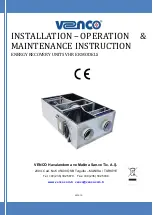
Electrolytic capacitors C2,C3 (fig. 3)
IGBT's Q1 (fig. 4)
Secondary diodes D22 (fig. 4)
Power transformer and filter reactance (fig. 2A)
6.1 Preparation for testing
6.2 Scheduled tests for theTECNICA 114 at low voltage
Probable cause
-
mechanical shock;
-
machine connected to power supply voltage much
higher than the rated value;
-
broken rheophore on one or more capacitor: the
remainder will be overstressed and become damaged
by overheating;
-
ageing after a considerable number of working hours;
-
overheating caused by thermostatic capsule failure.
Probable cause:
-
discontinuation in snubber network;
-
fault in driver circuit;
-
poorly functioning thermal contact between IGBT and
dissipator (e.g. loosened attachment screws: check);
-
excessive overheating related to faulty operation.
Probable cause:
-
discontinuation in snubber network;
-
poorly functioning thermal contact between IGBT and
dissipator (e.g. loosened attachment screws: check);
-
faulty output connection.
Inspect the windings for colour changes. Probable causes:
-
power source connected to a higher voltage than
280Vac;
-
ageing after a substantial number of working hours;
-
excessive overheating related to faulty operation.
It is important to check that all the connections are in good
condition and the connectors are inserted and/or attached
correctly. To do this, take the cables between finger and
thumb (as close as possible to the fastons or connectors)
and pull outwards gently: the cables should not come away
from the fastons or connectors.
If the power cables are
not tight enough this could cause dangerous overheating.
In particular, on the power board it is necessary to make
sure all the wiring is inserted correctly into the
corresponding connectors or fastons. Also make sure that
the connections to the dinse sockets are attached correctly
to the power board.
A) With the multimeter set in
mode check
the following components (junction voltages not less than
0.2V):
-
rectifier bridge D1
);
-
IGBT's Q1 (absence of short circuits between collector-
gate and between emitter-collector
);
-
secondary board diodes D22 between anode and
cathode (
). The secondary diodes can be checked
without removing the power board: with one prod on the
secondary board dissipator diodes and the other in
sequence on the two power transformer outlets;
B) With the multimeter set in ohm mode check the following
components:
-
resistor R2: 47ohm (pre-charge
);
-
resistors R3, R4: 22ohm (primary snubber
);
-
resistor R22: 10ohm (secondary snubber
);
-
thermostat continuity test on IGBT dissipator: clean the
resin from the bump contacts for ST1(A,B) and measure
the resistance over these two bump contacts, it should
be approx 0 ohm (
).
Before proceeding with troubleshooting, we
should remind you that during these tests the power source
is powered and therefore the operator is exposed to the
danger of electric shock. The tests described below can be
used to check operation of the power and control parts of
the power source.
A) Set up a multimeter in DC volt mode and connect the
prods to the OUT+ and OUT- bump contacts.
B) Position the potentiometer R75 to maximum (clockwise
as far as it will go).
to check correct operation of the
control circuit without powering the power board we
recommend carrying out the test given at point 6.2,
otherwise pass to the test at point 6.3.
A) Between the cathode of diode D10 (+) and the anode of
diode D11(-) insert a stabilised power supply that is able to
supply 40Vdc 500mA.
B) Set up the oscilloscope with the voltage probe x100
connected between the gate of Q1 and the earth on the
emitter, also of Q1
.
C) Switch on the stabilised power supply (initially set to 0V)
and gradually increase the generated voltage until it
reaches 40Vdc.
D) Make sure the waveform shown on the oscilloscope
resembles
.
if the signal is not present it may be
necessary to replace component Q1 or, alternatively, the
driver circuit U3, Q6 and Q7 (
).
E) Set up a multimeter in volt mode and make sure that (
):
-
the voltage over pins 2 and 1 of J8 is equal to +23V ±5%;
-
the voltage over pins 5 and 1 of J8 is equal to +5Vdc
±5%;
-
the voltage over pins 4 and 1 of J8 is equal to +500mVdc
±5%;
-
the voltage over pins 8 and 1 of J8 is equal to 0Vdc.
4.0 Checking the power and signal wiring
5.0 Electrical measurements with the machine
switched off
6.0 Electrical measurements with the machine in
operation
N.B.
diode testing
(fig. 3
fig. 4
fig. 4
fig. 3
fig. 3
fig. 3
fig. 2B
WARNING!
N.B.
(fig. 3)
fig. A N.B.
fig. 3
fig.
3
(No C3 on 230V version of Tecnica 114):
- 11 -
TECNICA 114
FIGURE A
SETTINGS:
· PROBE CH1 x10;
· 5 V/Div;
· 10 sec/Div.
·
:
60KHz ±10%.
· POSITIVE
AMPLITUDE IS
+16V ±10%;
· NEGATIVE
AMPLITUDE IS
-5V ±10%.
µ
VERIFY THAT:
THE FREQUENCY IS






































